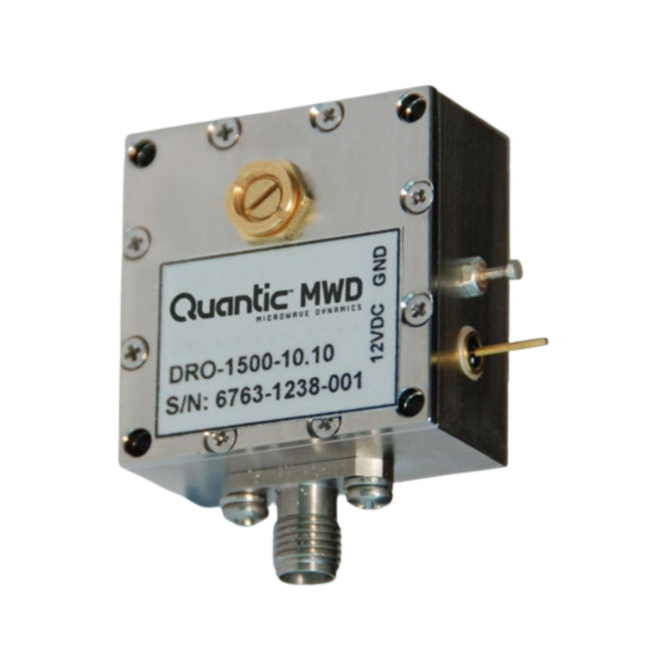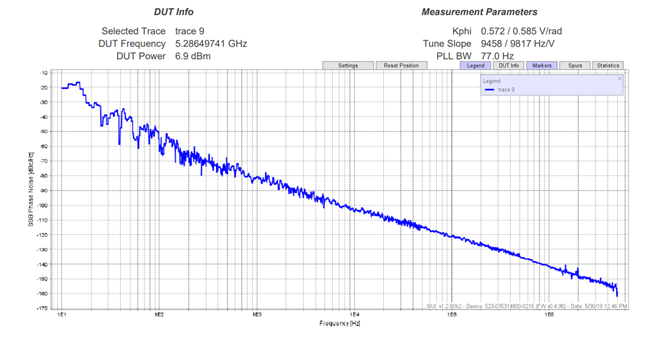In this blog, we uncover everything you need to know about Dielectric Resonator Oscillators (DROs), exploring the different functionalities, types, advantages, and disadvantages to help you make the right selection for your mission-critical frequency control and timing applications. Read on!
A DRO is essentially a frequency control and timing component that utilizes the resonant properties of dielectric materials to generate high-frequency signals. The core component of a DRO is the dielectric resonator, a ceramic or crystalline material with high permittivity and low dielectric loss. The dielectric resonator is responsible for providing the necessary feedback to sustain oscillations at a specific frequency.

The basic working principle of a DRO involves coupling energy from an external source into the dielectric resonator. This energy is then stored within the resonator, creating a resonance condition. The resonator’s inherent properties determine the frequency at which oscillations are sustained. By carefully selecting the dielectric material and designing the resonator’s geometry, RF Engineers can tailor the DRO to generate precise and stable frequency signals.
DROs come in many different configurations, and their types are often classified based on design, resonator geometry, and operating principles. It is important to note that the choice of a specific type of DRO depends on the application requirements, such as frequency stability, tunability, and size constraints. RF Engineers should carefully select the appropriate DRO configuration based on the desired performance characteristics and the specific needs of the system in which the oscillator will be employed. Here are some common types of DROs:
Fundamental Mode Dielectric Resonator Oscillators
In this type, the dielectric resonator operates in its fundamental resonant mode. The oscillator generates a signal at a frequency corresponding to the fundamental resonance of the dielectric material. This type is relatively simple and commonly used in various frequency control and timing applications.
Higher Order Mode Dielectric Resonator Oscillators
Unlike the fundamental mode DRO, higher order mode DROs utilize higher order resonant modes of the dielectric material. This allows for the generation of higher frequency signals. RF Engineers can select specific modes to achieve the desired frequency output, providing flexibility in oscillator design.
Dielectric Resonator Filters with Oscillation
This type combines the functionality of a dielectric resonator filter and an oscillator in a single device. They operate at the resonant frequency of the dielectric material, serving both as a filter and an oscillator. This integration simplifies the overall system design and can be advantageous in certain applications.
Dielectric Resonator Stabilized Oscillators
This type incorporates dielectric resonators to improve the frequency stability of traditional oscillators, such as Gunn diode oscillators. The dielectric resonator stabilizes the oscillation frequency, reducing phase noise and enhancing the overall performance of the oscillator.
Dielectric Resonator Varactor Oscillators
This type utilizes varactor diodes in conjunction with dielectric resonators to achieve tunability in the generated frequency. By varying the bias voltage applied to the varactor diodes, the capacitance changes, enabling frequency tuning. This type of DRO is suitable for applications requiring frequency agility.
Phase-Locked Loop (PLL) based Dielectric Resonator Oscillators
Some DROs are integrated into phase-locked loop systems. In such configurations, the DRO serves as the frequency reference, and the PLL circuit ensures precise control and synchronization of the oscillator frequency. This type is often used in applications where frequency accuracy and stability are critical. DRO based PLLs using high-quality reference oscillators combine very low phase noise of such references at low offset frequencies with low phase noise of the DROs at higher frequency offsets.
Surface Acoustic Wave (SAW) Resonator Dielectric Resonator Oscillators
SAW resonators, which utilize piezoelectric materials, can also be used as resonant elements in DROs. These DROs benefit from the unique properties of surface acoustic waves, offering advantages such as small size and low power consumption.
Multi-Resonator Dielectric Resonator Oscillators
This type of DRO utilizes multiple dielectric resonators to achieve stable oscillations across a broader frequency range. By selecting different resonators, each tuned to a specific frequency, engineers can design oscillators capable of operating in multiple frequency bands.
Frequency Stability
One of the primary advantages of DROs is their exceptional frequency stability. The resonance frequency is primarily determined by the physical dimensions and dielectric properties of the resonator, leading to minimal frequency drift over time and temperature variations.
Low Phase Noise
Phase noise is a critical parameter in many frequency control and timing applications. DROs typically exhibit low phase noise characteristics, making them suitable for radio frequency and microwave systems requiring high signal purity and minimal interference.

Small Form Factor
DROs are compact in size compared to other oscillator technologies like cavity resonators or coaxial resonators. This compact form factor is advantageous in frequency control and timing applications where space is a limiting factor, such as in portable communication devices.
High-Quality Factor (Q-factor)
DROs often have a high Q-factor, indicating the efficiency with which energy is stored and released during each oscillation cycle. A high Q-factor contributes to the stability and purity of the generated signal.
Wide Frequency Range
Dielectric Resonator Oscillators can operate across a wide frequency range, making them versatile for various applications in microwave and millimeter-wave frequency bands.
Limited Tunability
Unlike some other oscillator types, DROs may have limited tunability. Achieving precise frequency adjustments can be challenging, and this limitation might restrict their use in applications where constant frequency changes are required.
Sensitivity to Environmental Conditions
While DROs offer excellent stability, they can be sensitive to changes in environmental conditions such as temperature and humidity. Extreme variations may affect the dielectric properties of the resonator material, impacting the oscillator’s performance.
Complex Design Considerations
Designing an efficient DRO requires a deep understanding of dielectric materials, electromagnetic theory, and resonator geometry. This complexity can make the design process more challenging compared to simpler oscillator configurations.
Higher Cost
The manufacturing of high-quality dielectric resonators and the precision required in their fabrication can contribute to a higher overall cost compared to some alternative oscillator technologies.
DROs, with their myriads of types and configurations are critical components in modern radio frequency and microwave systems. DROs can meet the performance requirements of many different mission-critical frequency control and timing applications, from fundamental frequency generation to tunable oscillators and beyond. As frequency control and timing technology continues to evolve, the ongoing refinement of dielectric materials and oscillator designs promises to further enhance the performance and adaptability of DROs for many years to come.
The RF engineering team at Quantic MWD (Microwave Dynamics) has manufactured custom DROs for mission-critical applications for over 30 years. Located in Irvine, CA, contact our sales engineering team today to discuss your unique frequency control and timing application with us. We’re here to help.